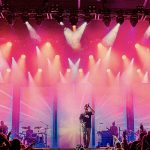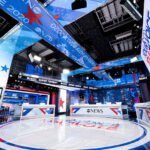After 19 years, the renowned country music artist Garth Brook knew that his return to New York City needed to be on a stage worth the wait. Having played in Central Park to nearly a million people in 1997, Brooks this summer took the field, literally, at Yankee Stadium in mid-July, becoming the first country music act to play the iconic Bronx ballpark. Joined by his wife and fellow country music star Trisha Yearwood, the massive stage design suited the epic scope of the venue, the event, and the artist himself.
The sweeping production design was done by Bruce Rodgers of Tribe Inc., who worked closely with the lighting designer Robert W. Peterson, principal of Real World Lighting Inc. Together they created an overall design that encompassed the stadium and allowed Brooks to play in both a grand and, at times, more intimate scale. The two nights of concerts were also filmed for later release so the designers needed to include that consideration into their final designs. The filming was handled by producer/director Jon Small, who also produced and directed the filming of Billy Joel’s Shea Stadium and Yankee Stadium performances.

A Big Embrace
For Rodgers the design began with Garth and reflected who Garth is to his fans, as he describes, “Garth and Jon had this concept, right from the beginning, of this circle, a circle of family and friends and fans, that’s where the design grew from really. You know it’s fun to take a design from scratch and see it come to life, but sometimes it’s also pretty amazing to support ideas; support concepts that an artist wants to realize. This was one of those times, so I started thinking about the circle idea, but then I also noticed that every dang picture of Garth is with his arms wide open. He’s a cowboy who wants to hug everybody; a big guy with big arms outstretched. So that’s the way I looked at it in thinking about the design; the set and stage was a reflection of his wanting to be able to embrace the stadium full of fans. He wanted to be able to get out there in the midst of the audience and touch as many people as possible.”

Like the Yankees themselves, a good game plan is important to smooth teamwork. “One of the important things we did early on, knowing we wanted to put a set design in Yankee Stadium, is the CAD work,” comments Rodgers. “You need to know if it will work, so we put together a CAD of the stadium, a CAD of the stage design, and we built it digitally to show Garth and Jon different POVs from like 50 different seats in the stadium. Because we visualized it, developed renderings and flythroughs as well as sightline studies, we could pretty much directly transfer our drawings into a set of working drawings for a shop to build from. That way we could also fold in Bob Peterson’s lighting design and the video technology, rigging and audio and all that equipment.”
Peterson, who has worked with Brooks’ team on previous broadcasts and television specials, is highly regarded by Rodgers and the two have worked together on various projects over the years. “I’ve known Bob for a long time, and he is an absolute pro and very much an artist when it comes to light,” states Rodgers. Peterson also enjoys the collaboration, noting “It is always a delight to work with Bruce. His innate sense of proportion is, to me, unmatched. No one does BIG better.”

For the lighting design, Garth asked Peterson for the two Yankee Stadium shows to stand on their own, separate from the tour Brooks was out on at the same time. He explains, “I started out with Dave Butzler, Garth’s longtime LD, who I’ve worked along with since 1992 when we did our first Garth Brooks television show. We share every bit of the planning to make sure that we’re both on the same page as to what’s going on when we work together. So I went out to see some of Garth’s touring shows and saw what Dave was using out there. He was out with a rig from Bandit, and they supplied the stage package for me at Yankee Stadium. I tried to mimic a little bit of those sources on the stage in Yankee Stadium. I wanted Garth and the Band to have some general sense of “home” when they got up on this massive stage.”

Filling the Stadium
For his role, Peterson points out, “Lighting needed to provide energy and excitement throughout the stadium. We completely engaged the stadium. We lit every last nook and cranny and every person in it from perimeter angles in the stadium itself, so it became a breathing part of the lighting design. We were lighting the show from the first moment for the camera, but given the 4K capability on the shoot, I don’t think the live show was at all compromised for the broadcast, in fact, I think it was embellished. There were 4K screens, 4K I-mag, 4K content and 27 4K cameras to capture it all.”

Peterson took advantage of Yankee Stadium’s recent LED lighting system upgrade, incorporating the stadium’s lights into his design. “We did actually use the new LED stadium lighting system during parts of the event. We built four separately cued moments throughout the show to take advantage of it. It was a very exciting part of it for me working in the stadium to be able to have that be a go-to element.”
Upstaging provided the additional stadium lighting package for Peterson’s design.

Followspots were a critical part of Peterson’s design, especially needing to cover Brooks as he moved over the large stage. “We counted mostly on followspots really. We had 21 total followspots on the show, including five 3kW Robert Juliats in the deepest balcony; six Strong Super Trouper long throws in two self-climbing towers; also four manned spots stuck way up in the corners of the roof to help us with the big circle and the long runways; and then six of the PRG GroundControl [Followspot System] units in the back. Dave did a phenomenal job calling the followspots on these shows, with me in the truck handling levels.”

Peterson also managed the development of all the screens content, working with Ben Knaf, Monica Rose, and Troy Fujimura, who was the d3 media server operator. As content producer, Chase Simmons provided organization and much of the “wing-it” content.

Both Rodgers and Peterson credit the great work of their suppliers for much of the show’s successful execution. “VER provided the video equipment,” says Rodgers, “They were amazing for us. All Access built the set, and they are just superb at large scale installations like this one. Of course, it was all made easier for all of us having Chris Balogh and the guys from Dan Parise’s company, Diversified Production Services (DPS) working with us, because they are very, very familiar with putting on concerts at Yankee Stadium. We also worked with Jim Brammer and his guys at Special Event Services,” who provided the G2 Structures stage. Peterson adds, “Bandit Lites did a really good job from the gear to our previz time in their facilities to the excellent crew they sent out to us.”

Lighting Project Manager & Lighting Director:
MONICA ROSE
Lighting Directors
KEVIN LAWSON
TYLER ROACH
TROY FUJIMURA
Gaffer
DAVID HUNKINS
Screens Director
DON CARR
Rigger
CARSTEN WEISS
Lighting Marshal
CAP SPENCE
Best Boy Electrics
BUDDY LUNN
COLE KIRACOFE
Key Lighting Technicians
JEFF ANDERSON
RICHARD ALLISON
TIM BROWN
Lighting Technicians
MATT BIALEK
ANDY CIMERMAN
PATRICK COWDEN
SARAH EUCKER
DAVID HAMILTON III
JON HOULE
BRIAN MONAHAN
GREG OGNE
MARK POWELL
ALEX SEILER
JEREMY WAHLERS
MIKE WALKER
BILLY WILLINGHAM
Draftsman
PAUL SKAIFE
–


